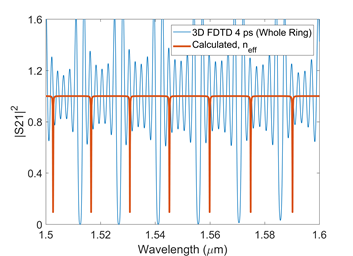TAGGED: Lumerical-FDTD, ring-resonators
-
-
August 29, 2021 at 8:49 am
tteo
SubscriberHi everyone,
I have been trying to obtain the spectrum of a all pass microring resonator on 3D FDTD. We see a ringing effect if the simulation time is not long enough (4 ps):
August 30, 2021 at 10:08 pmGuilin Sun
Ansys EmployeeThank you for sharing the reference. unfortunately we are unable to read without subscription. In general, you do not need special calculation for the result, as our built-in DFT power monitor automatically gives you the transmission.
Yes, you are right that for ring-resonator type, the simulation accuracy may be comprised by simulation time. For whatever the tool /post processing, in order to convert accurately the time signal to CW, it will require that the signal decays completely. any truncation of the signal will lead to reduced DFT accuracy. This is more phenomenal for large ring resonators with high Qs. Please refer this post: /forum/discussion/25276/simulation-time-and-frequency-domain-monitors
Depending on your goal, you may get some results quick without long simulation:
1: to get Qs and resonate wavelengths, you can simulate very short time by use of Q analysis group
2: to get transmission curve without very accurate value at the resonate wavelengths, you can use apodization: Understanding time apodization in frequency domain monitors
The accurate transmission at resonance will need much longer simulation time, as each round trip will contribute to the magnitude of the fields and thus the power.
Viewing 1 reply thread- The topic ‘Elimination of Rippling Effect in Microring Resonator Simulation’ is closed to new replies.
Ansys Innovation SpaceTrending discussionsTop Contributors-
3632
-
1313
-
1142
-
1068
-
1008
Top Rated Tags© 2025 Copyright ANSYS, Inc. All rights reserved.
Ansys does not support the usage of unauthorized Ansys software. Please visit www.ansys.com to obtain an official distribution.
-
The Ansys Learning Forum is a public forum. You are prohibited from providing (i) information that is confidential to You, your employer, or any third party, (ii) Personal Data or individually identifiable health information, (iii) any information that is U.S. Government Classified, Controlled Unclassified Information, International Traffic in Arms Regulators (ITAR) or Export Administration Regulators (EAR) controlled or otherwise have been determined by the United States Government or by a foreign government to require protection against unauthorized disclosure for reasons of national security, or (iv) topics or information restricted by the People's Republic of China data protection and privacy laws.












